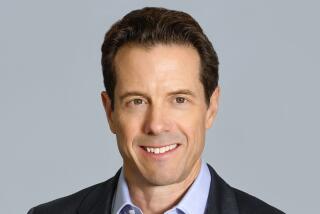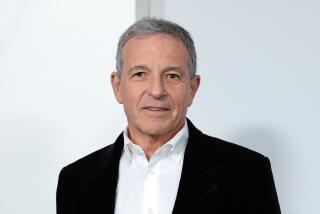Steve Jobs brought his magic to Disney
- Share via
When Walt Disney Co. looked to revamp its troubled retail stores in 2008, Chief Executive Robert A. Iger sought advice from the company’s largest shareholder, a foremost expert on the consumer experience.
Apple Inc. co-founder Steve Jobs had lured theme-park-size crowds to his company’s stores with daring architecture, no-pressure sales staffs and displays that enticed customers to come in and play with the tech world’s sexiest toys.
Though Disney sold its chain four years earlier, its name was still on the stores. Jobs told Iger that Disney needed to control those properties, arguing that a third party would never be as meticulous or creative a steward of the brand. After Disney bought back the chain, it was Jobs who urged the field testing of a fully stocked prototype before unveiling a new retail look to shoppers.
Photos: Steve Jobs | 1955-2011
“He felt that if we were going to be in the retail business, we should do it ourselves; we should own it,” said Andrew P. Mooney, Disney’s former head of consumer products.
Helping resuscitate Disney’s 220 North American stores is but one example of the powerful behind-the-scenes role Jobs played at the Burbank entertainment company as a board member and its largest individual shareholder. Jobs’ 2006 sale of Pixar Animation Studios to Disney gave him a 7.3% stake in the media giant and a seat on its board.
His legacy can be seen in virtually every corner of Disney, from the budding resurgence of Walt Disney Animation Studios to the $1-billion overhaul of Disney’s California Adventure and the expansion of its cruise line, according to the accounts of about a dozen current and former executives of Disney and Apple.
“Steve Jobs brought a perspective that was visionary because of his understanding of how technology was changing and what really resonates with consumers,” said Arvind Bhambri, an associate professor at USC’s Marshall School of Business. “If you look at Disney in the last few years, they started to regain their magic. I don’t think it’s a complete coincidence that the Pixar acquisition, and Steve Jobs’ role on the Disney board, coincides with Disney regaining its momentum.”
With Jobs’ death Wednesday, it’s unclear who will fill his board seat. Disney would not comment for this story.
Jobs was one of technology’s leading futurists and an advisor and confidant to Iger, who sought his counsel on one of the key issues confronting Hollywood: digital distribution. Disney was the first studio to sell its television shows and movies in Apple’s iTunes store, which yielded an early mover advantage.
Jobs lauded Disney’s swift adoption of new forms of distribution. After ABC unveiled the network’s iPad application, Jobs met with the development team in Iger’s office. One member of the team told friends that it was the equivalent of getting an audience with the pope, according to a participant at the meeting.
Disney’s digital forays sometimes placed the company and its chief executive at odds with the rest of the entertainment industry. Executives at rival studios criticized Disney, saying it rushed to offer its content on the latest Apple devices at the risk of disabling business models that had been carefully honed over decades.
The studio has maintained that it has benefited from associating its brand with the hippest tech gadgets, and reaped a financial windfall from leapfrogging its competitors onto the devices. Iger frequently has touted digital download statistics at Wall Street conferences and earnings calls.
Less tangible than his digital vision were the Apple marketing maestro’s insights about the power of a great brand, and the need to carefully tend it.
Jobs encouraged Disney executives to think in terms of “brand deposits” or “brand withdrawals” every time they made a movie, television show or consumer product.
“You could make the argument that Disney has been reshaped in Apple’s image: brand over everything, and an emphasis on quality,” said Oren Aviv, former head of production for Walt Disney Studios.
Over the last four years, Disney has shed assets that conflict with its identity as a purveyor of family entertainment, which people close to the company’s decision-making say reflects Jobs’ brand sensibilities. One prominent example: the 2010 sale of the Miramax Films specialty unit, whose sometimes crude and violent indie movies did not fit comfortably under the Disney marquee.
When the Disney board was prepared to sell the cruise line in 2007 and license its name to the new operator, Jobs questioned the virtue of the move, saying Disney needed to control its brand, according to one person’s account of the board meeting.
Jobs also brought his less-is-more mentality to Disney. He famously was quoted by BusinessWeek as saying that the secret to Apple’s product success “comes from saying ‘no’ to 1,000 things … [so] you can concentrate on the things that are really important.”
Nowhere is this thinking more evident than at the Walt Disney Studios. As declining DVD sales and theater attendance forced a reduction in the number of films it finances and markets, the studio has focused on select, high-profile pictures such as “Pirates of the Caribbean” and “The Muppets” that can be exploited across the company’s various entertainment units.
The same philosophy began to permeate Disney’s consumer products group, which abandoned a practice called “label slapping,” in which a toy maker uses a popular movie title to sell generic toys that are otherwise unrelated to the film. Instead, it embraced the oft-quoted motto of John Lasseter, the creative muse of Pixar, that “quality is the best business model.”
Jobs’ most lasting imprint on Disney is Pixar, the pioneering digital animation studio with an enviable track record: All 12 of its films have opened at the top of the box office.
Pixar’s enduring characters — Buzz and Woody from “Toy Story,” Lightning McQueen and Mater from “Cars,” and others — not only light up the big screen, but also populate the company’s theme parks, toy lines and interactive games.
It was Iger’s genius that kept Jobs and Pixar in the Disney fold in 2006 after relations between the two companies had soured. Pixar’s distribution deal with Disney was coming up for renewal and Jobs had broken off talks, vowing never to do business with the longtime partner as long as Michael Eisner was its top executive.
Disney’s own feature animation business was foundering with such box-office duds as “Home on the Range.” In relating Disney’s vulnerabilities at the time to investors later, Iger described a parade at the opening of Hong Kong Disneyland in September 2005: “I realized there wasn’t a character in the parade that had come from a Disney animated film in the last 10 years — except from Pixar.”
Within two weeks of taking over as Disney’s chief executive from Eisner in October 2005, Iger set relations back on track with Jobs, who at the time was Pixar’s chief executive and controlled nearly 51% of its stock.
Iger joined Jobs at a San Jose movie theater to announce that Disney’s ABC network would make its prime-time television shows available on Apple’s new video iPod. The groundbreaking deal burnished Iger’s reputation as a techno-savvy entertainment executive and set the stage, three months later, for Disney’s purchase of Pixar.
Although some on Wall Street criticized Iger, saying he overpaid, the deal prevented Pixar from falling into the hands of a rival studio. It assured Disney’s access to the beloved screen characters and helped infuse Disney’s storied, if struggling, animation studio with new life.
Pixar co-founder Ed Catmull and the studio’s top creative executive, Lasseter, assumed oversight of all Disney animation. They imparted a culture of relentless self-criticism that has been integral to the creative process at Pixar, which has been known to replace directors or rip up scripts in pursuit of quality.
Jobs required only one thing from Pixar, according to Marty Sklar, the retired chief creative executive of Walt Disney Imagineering, which develops attractions for the company’s theme parks. He once asked Lasseter what direction he got from Jobs. Sklar recalled: “John’s answer was: ‘He tells me, “Just make it great!’”
Although initial efforts by Lasseter and Catmull on projects already in development at Disney Animation, such as “Meet the Robinsons” and “Bolt,” met with indifference from U.S. audiences, the duo helped turn the studio’s animated fairy tale “Tangled” into a major hit last year.
Yet Disney’s ties to Jobs and to Apple have occasionally raised hackles in Hollywood. Some questioned whether Disney’s eagerness to offer its content on Apple’s latest devices threatened the lucrative status quo.
“We see [Jobs’] fingerprints on a lot of Disney strategy in adopting digital platforms,” said Laura Martin, media analyst for Needham & Co.
Disney’s decision to offer an application for watching episodes of its ABC television shows for free on the iPad roiled some in the industry. It undercut efforts by other networks to sell individual TV episodes through the iTunes store, and the initiative by online video service Hulu to require a monthly subscription fee to view the current season’s network shows on portable devices like the iPad. Hulu is jointly owned by Disney, News Corp., Comcast Corp.’s NBCUniversal and Providence Equity Partners.
When Wal-Mart’s movie service Vudu launched on the iPad this summer, every major Hollywood studio but one — Disney — participated. Vudu had designed a version of its website specifically for the tablet instead of requiring a download from the iTunes store. That approach allows Wal-Mart to keep all the proceeds whenever users buy or rent movies — in effect denying Apple its usual 30% cut of any transaction.
Disney declined to publicly state its reasons for the decision.
Alfred E. Osborne Jr., senior associate dean and expert in corporate governance at UCLA’s Anderson School, said Jobs’ death would leave a void on Disney’s board, but one less devastating than when its founder, Walt Disney, died.
“For years, they’d sit around and ask, ‘What would Walt do?’” Osborne said. “The challenge of having a visionary that is so transformative and dominant is that everybody looks to him for leadership and they sometimes check their brains at the door.”
Osborne said Disney board members would now need to assert their leadership in the absence of Jobs’ forceful presence.
Photos: Steve Jobs | 1955-2011
More to Read
Inside the business of entertainment
The Wide Shot brings you news, analysis and insights on everything from streaming wars to production — and what it all means for the future.
You may occasionally receive promotional content from the Los Angeles Times.










